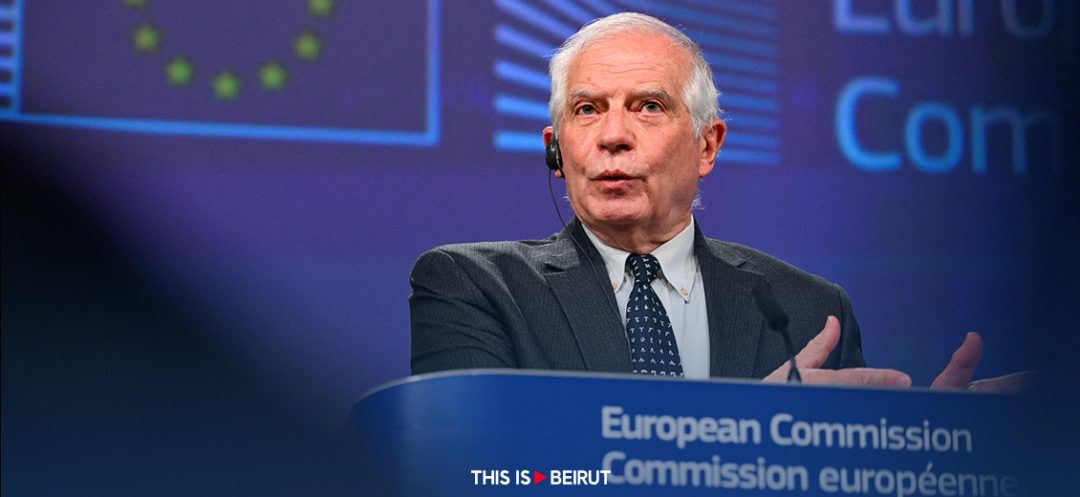- Home
- Middle East
- EU Proposes Increased Military Aid for Ukraine

©(Photo by JOHN THYS / AFP)
European Union officials revealed on Tuesday an ambitious plan to significantly increase weapons manufacturing and acquisition within the bloc. This initiative aims to reduce dependence on US arms and comes in response to Russia's invasion of Ukraine.
EU officials unveiled on Tuesday an ambitious proposal to massively boost weapons production and procurement in the bloc to shift from a reliance on US arms and in reaction to Russia's invasion of Ukraine.
The European Commission says that the 27-nation bloc is facing a new "security paradigm" with an expansionist Russia operating a wartime economy as it presses into year three of the conflict with Kyiv.
The European Defense Industrial Strategy aims, over the long term, to give incentives to European arms manufacturers to invest more, make their production more agile and – for the first time – to collectively catalogue what they have available.
"We must take more responsibility for our own security, while, of course, remaining fully committed to our NATO alliance," said European Commission Vice President Margrethe Vestager.
"We need to get that transatlantic balance right, irrespective of electoral dynamics in the US," she told reporters, in a nod to Republican White House hopeful Donald Trump casting doubt on the US commitment to its NATO allies, should he win reelection.
The question of financing the ambitious initiative is problematic for a continent that has trimmed defense investment for decades, following the collapse of the Soviet Union.
Breton spoke of an ultimate need for some 100 billion euros ($110 billion) for the European Union to rival the Pentagon and US defense industry.
To kickstart the project, the commission plans to set aside 1.5 billion euros from the EU's current budget that runs to 2027 – an amount that Vestager acknowledged "is not a lot of money" given the scale of the initiative.
"But it can still work as an incentive, as a bonus... because the real funding for a stronger defense comes from member states and that funding will increase over the years to come," she said.
Some countries, such as France, back an idea of EU bonds to finance a buy-European weapons production base, similar to what was done to finance economic recovery from the COVID pandemic.
But "frugal" countries, such as Germany, are against that. They are concerned that it will centralize budget power in Brussels and override national sovereignty over defense issues.
There is also a debate over using money generated from frozen Russian assets in the EU to help fund the initiative, though the bloc's foreign policy chief Josep Borrell said that "is still not decided and there are different views" among member states.
While the EU and member countries have supported Ukraine financially and with military weapons and equipment, arms production has come up short with the bloc missing a target to give Kyiv a promised one million artillery shells.
Breton said that the bloc was now providing Ukraine around 80,000 shells per month.
The EU's 27 member countries spent more than 100 billion euros on defense purchases between Russia's February 2022 invasion of Ukraine and June last year, Vestager said.
The EU's proposed strategy aims to have the trade of weapons within the bloc reach 35% of the total value of the EU defense market by 2030.
Member states will also be encouraged to procure European weapons to a level of at least 50% of their defense budgets by 2030 and 60% by 2035.
A defense industrial readiness board would be created to bring together member countries, the commission and the EU's top diplomat, currently Borrell, to coordinate.
Marc Burleigh, with AFP
EU officials unveiled on Tuesday an ambitious proposal to massively boost weapons production and procurement in the bloc to shift from a reliance on US arms and in reaction to Russia's invasion of Ukraine.
The European Commission says that the 27-nation bloc is facing a new "security paradigm" with an expansionist Russia operating a wartime economy as it presses into year three of the conflict with Kyiv.
The European Defense Industrial Strategy aims, over the long term, to give incentives to European arms manufacturers to invest more, make their production more agile and – for the first time – to collectively catalogue what they have available.
"We must take more responsibility for our own security, while, of course, remaining fully committed to our NATO alliance," said European Commission Vice President Margrethe Vestager.
"We need to get that transatlantic balance right, irrespective of electoral dynamics in the US," she told reporters, in a nod to Republican White House hopeful Donald Trump casting doubt on the US commitment to its NATO allies, should he win reelection.
The question of financing the ambitious initiative is problematic for a continent that has trimmed defense investment for decades, following the collapse of the Soviet Union.
Funding Questions
Breton spoke of an ultimate need for some 100 billion euros ($110 billion) for the European Union to rival the Pentagon and US defense industry.
To kickstart the project, the commission plans to set aside 1.5 billion euros from the EU's current budget that runs to 2027 – an amount that Vestager acknowledged "is not a lot of money" given the scale of the initiative.
"But it can still work as an incentive, as a bonus... because the real funding for a stronger defense comes from member states and that funding will increase over the years to come," she said.
Some countries, such as France, back an idea of EU bonds to finance a buy-European weapons production base, similar to what was done to finance economic recovery from the COVID pandemic.
But "frugal" countries, such as Germany, are against that. They are concerned that it will centralize budget power in Brussels and override national sovereignty over defense issues.
There is also a debate over using money generated from frozen Russian assets in the EU to help fund the initiative, though the bloc's foreign policy chief Josep Borrell said that "is still not decided and there are different views" among member states.
'Kick Up a Gear'
While the EU and member countries have supported Ukraine financially and with military weapons and equipment, arms production has come up short with the bloc missing a target to give Kyiv a promised one million artillery shells.
Breton said that the bloc was now providing Ukraine around 80,000 shells per month.
The EU's 27 member countries spent more than 100 billion euros on defense purchases between Russia's February 2022 invasion of Ukraine and June last year, Vestager said.
The EU's proposed strategy aims to have the trade of weapons within the bloc reach 35% of the total value of the EU defense market by 2030.
Member states will also be encouraged to procure European weapons to a level of at least 50% of their defense budgets by 2030 and 60% by 2035.
A defense industrial readiness board would be created to bring together member countries, the commission and the EU's top diplomat, currently Borrell, to coordinate.
Marc Burleigh, with AFP
Read more



Comments